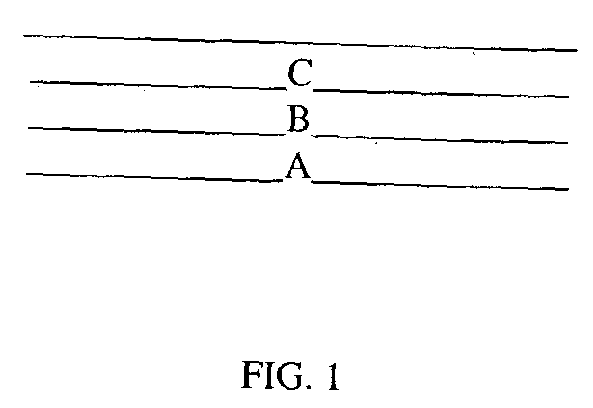Method for hydrophilizing materials using hydrophilic polymeric materials with discrete charges
a polymer material and hydrophilic technology, applied in the field of hydrophilizing materials with discrete charges, can solve the problems of reducing the effectiveness of nonwoven materials treated with surfactants, the tendency of partial or full charges imparted on thermoplastic surfaces by various high energy surface treatments to dissipate, and the durability of most high energy surface treatments, etc., to achieve the effect of increasing the hydrophilicity of materials, increasing the hydrophilicity of such materials, and high energy treatmen
- Summary
- Abstract
- Description
- Claims
- Application Information
AI Technical Summary
Problems solved by technology
Method used
Image
Examples
examples
Strike through results for SMS polypropylene nonwoven materials (13 grams per square meter) exposed to a Laboratory Corona Treater (Model# BD-20AC, manufactured by Electro-Technic Products Inc., USA) and coating compositions are reported in the following Table (wherein the balance of the composition comprises water).
Strike Through Times / CoronasecondsTreat-2nd3rdComposition Applied to Nonwovenment1st InsultInsultInsultNoneNo>120——NoneYes10-186-104-100.2% Laponite RD1No>120——0.2% Laponite RD1Yes4.73.22.80.2% Disperal P22No>120——0.2% Disperal P22Yes2.12.32.30.2% Polyethyleneimine, MW = 3000No>120——0.2% Polyethyleneimine, MW = 3000Yes1.31.61.80.2% PolydiallydimethylammoniumNo>120——chloride3, very low MW0.2% PolydiallydimethylammoniumYes4.72.52.4chloride3, very low MW0.2% Polyacrylic acid, sodium salt4No>120——MW = 35000.2% Polyacrylic acid, sodium salt4Yes5.32.82.9MW = 35000.2% Polyvinylpyrrolidone,No>120——MW = 360K0.2% Polyvinylpyrrolidone,Yes1.61.91.9MW = 360K
1Southern Clay Products...
PUM
| Property | Measurement | Unit |
|---|---|---|
| contact angle | aaaaa | aaaaa |
| strike-through time | aaaaa | aaaaa |
| diameter | aaaaa | aaaaa |
Abstract
Description
Claims
Application Information
 Login to View More
Login to View More - R&D
- Intellectual Property
- Life Sciences
- Materials
- Tech Scout
- Unparalleled Data Quality
- Higher Quality Content
- 60% Fewer Hallucinations
Browse by: Latest US Patents, China's latest patents, Technical Efficacy Thesaurus, Application Domain, Technology Topic, Popular Technical Reports.
© 2025 PatSnap. All rights reserved.Legal|Privacy policy|Modern Slavery Act Transparency Statement|Sitemap|About US| Contact US: help@patsnap.com

